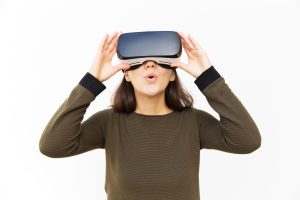
In the evolving world of architecture, where innovation is paramount, Virtual Reality (VR) is emerging as a pivotal tool that architects are using to maximize creativity. With its immersive visualization, real-time collaboration, and iterative design possibilities, VR has become a game-changer for the architectural industry. Here’s an in-depth look at how VR is redefining architectural creativity in 2024.
Immersive Design Exploration
Traditional architectural tools such as 2D blueprints and even 3D renderings can only provide a limited view of the final product. VR, however, allows architects to step into their designs and visualize them in an immersive 3D environment. This immersive experience offers a true sense of space, scale, and depth, giving designers insights into their projects that were previously unattainable. For instance, an architect can gauge how natural light will fill a space throughout the day or assess the ergonomics of different room layouts. This level of interaction fosters creativity by enabling architects to understand the environment better, leading to more innovative design decisions.
Real-Time Design Iteration
Incorporating VR into the design process allows architects to make real-time adjustments to their designs. Traditionally, modifying a design involves redrawing or remodeling, which can be time-consuming. With VR, architects can instantly visualize changes in colors, materials, and layouts, enabling them to test and iterate on their designs dynamically. This agility leads to faster decision-making, more creativity in exploring different options, and ultimately more refined and innovative designs. The ability to visualize changes instantaneously also means fewer costly changes during the later stages of the project.
Enhanced Collaboration
One of the most transformative aspects of VR in architecture is its ability to enhance collaboration. Architectural projects involve various stakeholders, including clients, designers, engineers, and contractors, who often work from different locations. VR allows these stakeholders to enter the same virtual space, enabling them to walk through the design together and interact with it in real-time. This shared experience allows for a richer exchange of ideas, immediate feedback, and better alignment of the project’s vision, resulting in a more collaborative and creative process.
Freedom from Physical Constraints
In the world of architecture, physical limitations often constrain creativity. However, VR provides a platform where architects can experiment with bold, unconventional designs that push the boundaries of traditional architecture. In the virtual realm, the laws of physics don’t restrict design exploration, enabling architects to visualize concepts that may not yet be feasible but can inspire future trends. This freedom allows for creative experimentation without the risk of failure, leading to innovative architectural solutions.
Storytelling and Presentation
Effective storytelling is crucial in presenting designs to clients, and VR takes this to a new level. Instead of relying solely on 2D drawings or 3D models, architects can use VR to take clients on a virtual tour of their future buildings. This immersive experience helps clients understand the design better and connect with the vision more personally. The virtual walkthroughs can also help identify potential issues early on, allowing for adjustments before construction begins. This enhances the creative process and strengthens the client-architect relationship.
Overcoming Challenges in VR Adoption
Cost and Technology Investment
Adopting VR technology can be costly, requiring investment in high-quality headsets, workstations, and software. However, the return on investment comes from enhanced creativity, reduced rework, and improved client satisfaction. Architects can start small, adopting basic setups and gradually upgrading as proficiency grows.
Learning Curve
Implementing VR in architectural practice involves a learning curve, which can initially slow down the design process. Investing in training and starting with smaller projects helps teams overcome this challenge. Encouraging experimentation and continuous learning will help teams adapt and maximize the technology’s potential.
Integration with Existing Tools
Integrating VR tools with existing architectural software can be challenging, requiring seamless data exchange. Working closely with IT teams and software providers to identify compatibility issues and implement solutions can help integrate VR smoothly into existing workflows.
Case Studies: Real-World Applications of VR in Architecture
Enhancing Client Engagement
A well-known architectural firm used VR to present its vision for a new urban development. By providing a virtual walkthrough, the firm could showcase the project’s design and vision in a way that engaged clients and led to faster decision-making.
Improving Design Accuracy
Another firm used VR to refine a challenging multi-purpose building project. By allowing the design team to visualize spatial relationships and ergonomics in a virtual environment, they identified and resolved design issues early, leading to a more accurate final design.
Conclusion
In 2024, VR is an indispensable tool in the architectural industry, enabling architects to push the boundaries of creativity. From immersive visualization to real-time design iteration and collaborative teamwork, VR enhances every aspect of the design process. To explore how VR can transform your architectural creativity, reach out to VRchitects.





